Robert Mosher Ingraham and Hazel Marie Herrick From New York to New Mexico
Editor's Note: When you see these three dots surrounded by a gray rectangle — 1 — you can click on it to get further information about the topic. Click a second time, and the message goes away.
Robert Mosher Ingraham (1911-1995) and Hazel Marie Herrick (1914-2010)
Memories of Birthplaces and Parents
Robert Mosher Ingraham was born on 15 January 1911, in Hornell, Allegany County, New York. He was the son of Robert Lee Ingraham and Ratie Jane Mosher. While his father was always called Rob, Robert Mosher Ingraham was always called Bob.
Bob wrote: “My birthplace was a two-story house at the north end of Irving Place, a short street which led to the fairgrounds in Hornell, New York.”
Hazel Marie Herrick Ingraham was born 31 Aug 1914 in Caton, Steuben County, New York. She was the daughter of Bert Herrick and Grace Brand. She grew up on a small farm near Caton.
Hazel said: “I was born at home on my parents’ farm near Caton, New York. We were nine miles from Corning which had a hospital, but not many women went to a hospital in those days to have their babies."
This is Hazel's description of the home she grew up in:
"My father had built the house, the one and only house he ever built. I don’t know if he had help. There was running water in the pantry, but you went outside for the outhouse; a little bathroom inside, but no running water; a screened front porch with white pillars and a couch; a living room with a separate dining room, and hardwood floors throughout."
"We had things that other people didn’t have. We had a piano, for instance, and I played piano by ear. Meal preparation took place in the kitchen. We had a large cook stove which burned wood and coal. It had an attached hot water heater. We also had an oil stove which my mother used in the summertime to avoid a hot stove."
"There were stairs that led into three bedrooms. I shared a bedroom with my sister, Helen. Another bedroom was the master bedroom. The third bedroom was for my brother, Ted, but my Aunt Julia often came to visit and Ted would sleep on a cot. There were two windows in our bedroom, one on each wall. We had a closet, which was unusual for that time. I got along well with my sister. I don’t remember arguing about anything with her. I was a little bigger for my age." 2
Memories of Grandparents
Bob's maternal grandparents were George Henry Mosher and Gertrude Wheeler. They lived in Hornell when he was a young boy. They had moved from Oakland, New York, a tiny hamlet near Nunda, and about 30 miles from Hornell. Bob wrote, "[Grandma and Grandpa’s house] was a big rambling one with many rooms, a basement with a dirt floor, and a huge attic...[where] I spent many hours playing. The house was owned by a wealthy woman named Newman and I used to go with my father when [I was] around five years of age [to pay] the rent." 3
Hazel wrote:
“I never met my mother’s parents who were Samuel Perkins Brand and Martha Elizabeth Hatch. 4 They lived in many different places and my mom always saw to it that we wrote letters. My mother wrote to them and contacted them when she was still able to. My mother was not particularly close to her siblings."
"My father’s parents were Augustus C. Herrick and Josephine Niver. Grandpa Herrick died before I was born, but I went down to see Grandma Herrick in the Herrick family house. She was living there in a wheelchair. Cousin Durlin — his mother was my dad’s cousin — and his wife lived with her and took care of her. I saw her in about 1920 and she died some time after that. She was in her bedroom, I remember. She wore a black satin dress and white lace shawl over her shoulders. She wore a little lace cap over her hair. There was chocolate pie — two pieces for my grandmother and one piece for me. It was just a short walk from our house to theirs. The house burned down many years later.”
Childhood Illness and Home Chores or Activities
Bob:
“My family moved from Irving Place to an upstairs apartment in the house where my grandparents Mosher lived on Kansas Avenue a short time after I was born. Before that, I contracted typhoid fever and nearly died when I was barely six months old. ...I was starving to death when my father conceived the idea of getting me to suck on orange pulp contained in a clean cloth. The very suggestion of this infuriated my grandmother and [Great] Aunt Mary [older sister of Gertrude Wheeler Mosher] who berated him for such an insane idea. He did, however, and I immediately began to improve and, obviously, survived.”
“In our house on Kansas Avenue I played in the stairwell outside our apartment door. It was there I conducted various experiments with falling objects. I dropped assorted items to the landing below and observed the results. It was only when my mother caught me about to drop one of the family cats that the experiments concluded. I was four years old, nearly five. The experiments were resumed many years later when I was more than 50, although on a slightly more scientific scale. That was when I invented release mechanisms and dropped objects from my big kites, sometimes from as much as three thousand feet.”
Hazel:
“My mom every spring ordered her chickens which, as I recall, were about 500 White Leghorns. The chore that I thoroughly hated was taking turns at night to sit with the chickens. We sat there for a couple of hours. There was a heater to keep them warm and they would snuggle up against it, but sometimes they got too close and in the morning they’d be dead and we had to take them out. Before shipping the eggs to New York, I had to pack them in crates that held 12 dozen eggs. I hand washed each egg and got paid a penny a dozen. This was about 1924 or 1925.”
The road that went past our house was well traveled, as it went to Lynley. As a young girl, I knew everyone there. It changed a lot when I went back to visit years later. The Old Herrick home had burned; Uncle Eber’s home was gone, too. It was so different I couldn’t even figure out where I was!”
Growing up
Bob spoke of his childhood nostalgically: “By today’s standards we [the Ingrahams] were poor people. Almost no one in our class owned a home and most people rented, but we were surrounded by people in the same circumstances and did not feel any discrimination. Social life was quite limited in those days. We were confined to our neighborhoods year in and year out. Our only venture outside the neighborhood was made on a comical little trolley car which bobbed and ground its way across two rails. For five cents you could ride about three miles — the width of Hornell. Once in a great while we took a picnic to Glenwood, a place between Hornell and Canisteo. This was on a larger street car which plied between the two towns. Glenwood had a Ferris Wheel and a Merry-Go-Round. At other times we would walk to visit friends or go to the store. In the winter, often with considerable snow on the ground, we would visit family or friends several blocks away and my father [would] pull Lee [my brother] and me on a sled which was narrow and high enough so the snow didn’t get on us.”
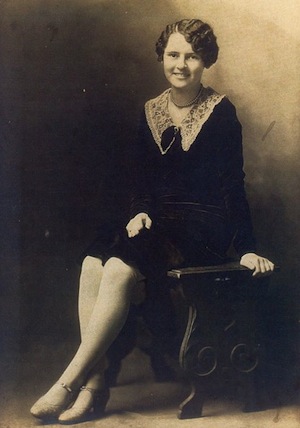
Hazel (in photograph at right at about age 18) does not remember many social events, but she remembers her father’s two cars and their horse and buggy: “My dad had the first car in Steuben County. People from all over came to see our car: an Overland. It had four doors with a back and front seat. We also had a Ford, with isinglass curtains, that had to be cranked up to start. My dad would get very mad trying to crank up that car. When we went to church in the wintertime, we’d take one horse and the sleigh and cover up with a bearskin rug to keep warm. The church was about a mile away. It was the East Lynley Baptist Church and, as far as I know, it’s still going. ... I was baptized as a teenager in a creek nearby. The whole family went, but Dad wasn’t much of a real churchgoer. We did have a family bible at home. The Ladies’ Aid Society sponsored dinners at people’s houses and we had them once or twice at our house.”
Siblings
Hazel had an older sister, Helen, and a younger brother, Ted. Hazel and Helen shared a room, but Helen died when she was 17 while mowing the lawn. Ted upset Hazel’s parents. “He got a girl pregnant,” Hazel says, “when he was just a teenager. My parents were very upset. He married the girl, but we thought they weren’t a good match.”
Bob was close to his older brother, Lee, but he wrote in his memoir: “"My brother entered school when he was five and for about two and a half years I was alone with no one to play with during the day. When I began school at five, it was in kindergarten and only in the afternoons. I acquired a playmate who lived across the street but he went to school in the mornings so we were only together in the early evenings and on weekends. On my tricycle, I spent much time exploring. I pedaled up to the railroad tracks and watched the mighty steam locomotives moving long freight trains out of the yards. I waved to the engineer. I thought those big engines which always seemed to be looking sternly ahead, were simply magnificent."
For Bob: His father gone to fight in The Mexican War and Finding Work
After Bob’s father served during the war against Mexico and moved to a couple of jobs because of union problems, the family moved to Painted Post to live in a rented house on West High Street while Bob’s dad worked for Ingersoll-Rand. Bob wrote of this time: “Both Lee and I were terribly homesick for a time and the following fall and winter proved to be a nightmare of cold and sickness for everyone because the great influenza epidemic had broken out and was sweeping the country. Soldiers in camp preparatory to going overseas were stricken by the thousands and many died. None of us got the flu then. I remember when the undertaker came to take the bodies of two young girls from their home across the street from us. They were sisters, 16 and 17, victims of the flu epidemic.
“We began to enjoy Painted Post. Hornell was adjacent to Allegany County and the terrain was much like the oil-field area with little woodland, barren hills, and few streams. Painted Post was in a wide river valley among the foothills of the Appalachian Mountain range and was surrounded by streams and large woodlands. We had lots of fun exploring the woods, playing in the creeks and, when older, swimming and fishing in the river.”
“When I was seven years old, our house on West High Street was sold and we had to move. Dad found a big old rambling house on Hamilton Street on the edge of town and we moved there about a year after moving to Painted Post. The rent as I recall was $18 a month. On West High Street we had had no bathroom — just an outdoor privy. We had a bathroom in the Hamilton street house but no hot water tank, nor did we have electric lights. The cleaning and filling of kerosene lights was a daily ritual. The house was a dismal place and hard to heat. However, outside, we were close to the woods, and had a wonderful hill to slide down. There was a steady running brook in a field just below the house.
For Hazel: Growing up on the Farm
“There was a large garden and a small barn on the property and the first garden my father planted produced 40 bushels of potatoes. Since it was war time he sold several bushels at $4.00 each, a price unheard of prior to the war.” Hazel’s father did not spend all of his time on the farm. Hazel said of him: “He was not a farmer. It was not in his blood. He was a natural-born salesman and he sold insurance and lightning rods for houses and barns everywhere. He’d be gone for a few days at a time. He was also the Town Supervisor and involved in politics. He had a county job, too, in Bath. He travelled there to attend county meetings. He was on the Steuben County Board of Supervisors. He wore high-button shoes and posed in 1921 in front of the Bath courthouse.
“He kept his temper contained a lot of times. I knew when he was mad but he’d keep it under his hat. We were not affectionate to each other, but my dad was a social person, more so than his family. He never talked about any other girl/lady in his life besides my mom, but he sure fell for my mother when he saw her.”
The 1918 Influenza
With the end of the war came near calamity for the Ingraham family. Bob Ingraham wrote: “In the fall of 1918 disaster overtook us in the form of influenza and an ensuing bitter winter. It all began with the news that an armistice had been signed in France. World War I was over. The whole nation went into a frenzied celebration. It was a warm day for November 11 and when the whistles and sirens started to sound at 11 a.m. my brother Lee and I hurried downtown to join the crowds. Parades formed and everyone thought he had to add to the tremendous din that must have been heard for miles around. Lee and I found an old wash boiler which we carried by the handles and beat upon with sticks.
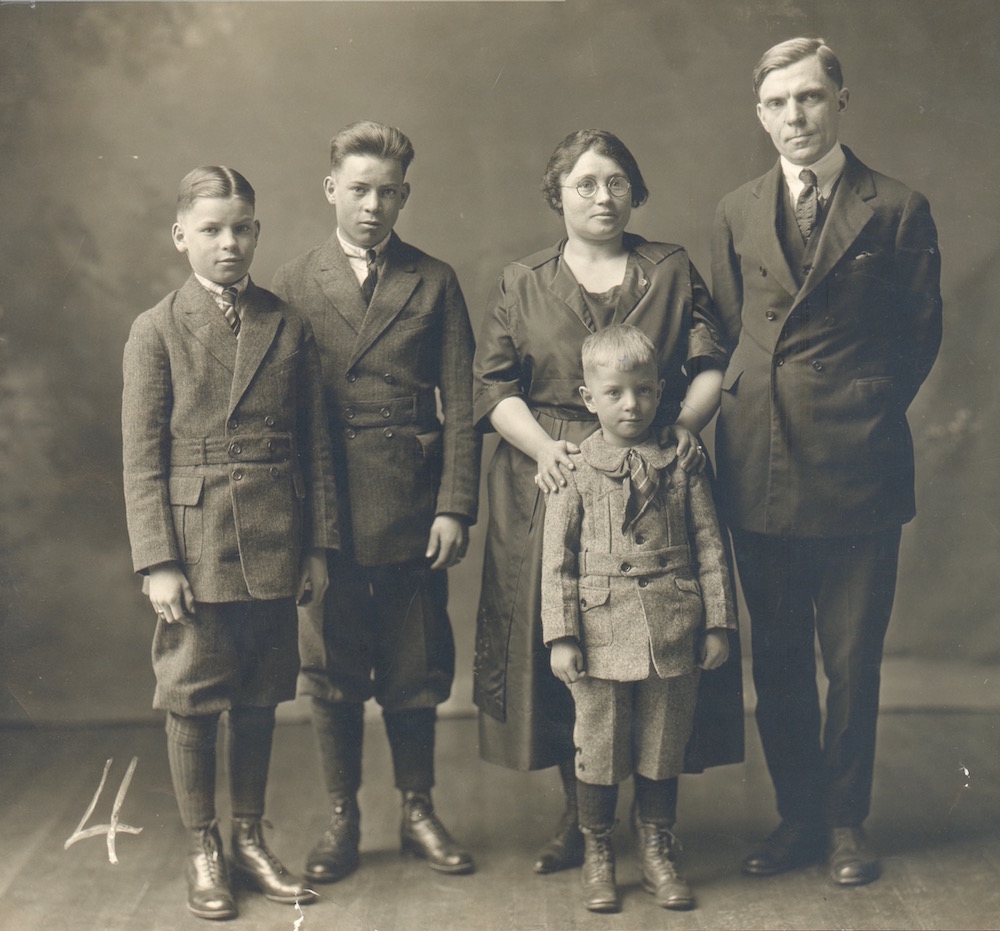
“In the early afternoon we went home to find my father so sick he could hardly stand. He had walked downtown to send a telegram to my grandparents [George Mosher and Gertrude Wheeler] in Hornell, asking them to come and help. We had no lunch and we played outside in the afternoon until Lee suddenly got sick and joined the rest of the family. About five o’clock, my grandparents arrived, having come down on the Erie railroad. They walked all the way from the railroad station in Painted Post to our house which was about a mile and a half.
“It wasn’t long before my grandmother succumbed to the flu so we had to send for my [Great] Aunt Mary [older sister of Gertrude Mosher] Allen who lived in Dalton, about 25 miles from Hornell. She also arrived by train and took over the nursing, cooking and general housekeeping chores, not an easy job with six very sick people to care for. My grandfather [Mosher] did all he could and smoked his meerschaum pipe continuously. He never got the flu. I have always wondered if maybe the pipe immunized him.
“Aunt Mary didn’t last long but by the time she got sick my father was able to get up and do a few things and then my Grandmother also improved and things began to look better. The winter had become very severe and the environment was very dismal. Old Dr. Shumway came to see us every day although the whole town was afflicted and he worked day and night, as did his son. He gave us big yellow pills and words of encouragement. The total doctor‘s bill was $30 or about $1.00 per house call.
“Things eventually got better. My father went back to work and Lee and I to school.” The 1918 flu epidemic was over.
Going to School
Hazel loved school. Her elementary school was a “one-room school about half a mile from our house. Much to the enjoyment of the whole class, there were probably five different grades. The school teacher asked if she could board with us and go home on the weekends. She and I slept together for at least a couple of years. Kids in school figured you were the teachers’ pet if the teacher lived with your family. Later, the school was added on to and a family with 8 or 10 kids lived there.
“We had entertainment and plays for the parents. We played ball outside a lot during recesses. One game I remember was ‘Annie over the Schoolhouse.’ You throw the ball over the schoolhouse and then try to get to the other side before another group.
“I also played baseball and Hide ‘n’ Seek at home. A boy, Jimmy, once made eyes at me. He winked at me, and I couldn’t figure out what he was doing! He had an older brother and came from a large family. His name was Chesley. He was at the dangerous age of 16 or 17 and the teacher (the one who lived with us) had a big fat crush on him! I liked school and got good grades. I didn’t like arithmetic, but I liked English and writing.”
Meeting in High School, Learning how to Make Money
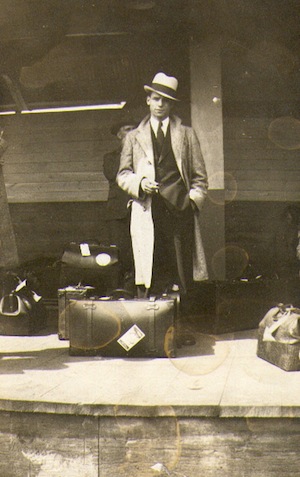
Bob and Hazel met in high school. There had been only ten in her small country school, so she found the adjustment to a “big” high school somewhat difficult. She saw Bob in the hallway one day and thought he was very handsome. They dated, but it would be a while before marriage would take place. In the photograph at the right he is about 30 years old and has gone to Silver City, New Mexico (where his parents had moved) to decide if he would move himself and his family there (they would eventually move).
Bob began to look for ways to earn money: “Lee began going to Hornell [in the summer] to caddy at the Hornell Country Club. He stayed home after two summers of that and opened a shoeshine stand at Norm McCabe’s barber shop on the village square in Painted Post. I then went to Hornell and caddied for three summers and became caddy master at the club.
“We were supposed to get thirty-five cents per round (nine holes). The course had six fairways that ran uphill and carrying a heavy bagful of clubs just one round was hard work. I used to do as much as five rounds per day in addition to picking up hundreds of balls driven in golf lesson sessions or hunting for lost golf balls. We got ten cents for each lost ball turned in. Most had the member’s name stamped on them.
High School and Beyond
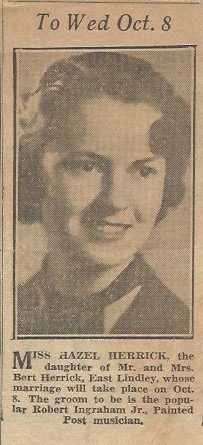
Because of Bob’s late returns to school, it took him longer to finish high school than it did Hazel.
After graduation, Hazel went to live in Elmira to attend hairdresser’s school.
“I had a roommate and I went home to Caton on the weekends,” she said. “Dad would pick me up. I learned to dye hair. The big machines were atrocious. I can remember when machineless perms came in. Machines with wires going to the woman’s head and heating elements in the rods. Bob was working for a department store with Schultee’s in Corning. He’d come down to see me. He had to talk his dad into borrowing the family car which was a Chevy with wire wheels."
"I worked in a beauty shop in Elmira in a big department store called Izzars for a year and a half and then in Corning. I didn’t drive, so Corning was better. I was working right on the Main Street in Corning — an older woman’s shop. I was there for about three-and-a-half years. I worked for about a year after we were married, but then Bob didn’t like me being gone from home, so I stopped working. He had gotten a raise at Ingersoll-Rand so we had a little more money.”
Marriage and Children
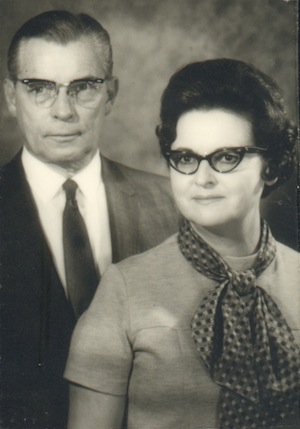
Bob Ingraham and Hazel Herrick waited five years before they got married. Hazel always told her children that they had to wait because of the Depression — money was tight. That may well have been at least one of the reasons. But it was also necessary for Bob to finish high school (which he did at almost the age of 20) and he played in a band which he thoroughly enjoyed. Hazel continued to do her hairdressing and they waited until they had enough money.
Robert Mosher Ingraham and Hazel Marie Herrick married on October 8, 1935, at Hazel’s parents’ farm near Caton. Hazel says she “bought a dress — sage green — that I saw in a store window. I liked the way it was made. I also bought green suede shoes to go with it. Aunt Penny from Detroit came for the wedding; she made the rolls for the chicken dinner afterwards.”
Bob and Hazel would have two children, first a girl, then a boy:
- Helen Suzanne b. 4 Dec 1937
- Robert Philip b. 14 Jan 1943 in Bath, New York, USA
After they married, they lived in Savona, New York.
On to New Mexico!
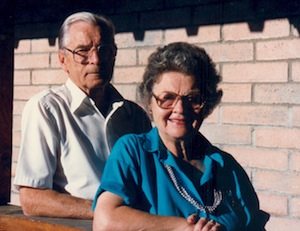
After several years of living in New York, Bob and Hazel followed Bob’s parents, Robert Lee Ingraham and Ratie Jane Mosher to New Mexico in 1949, living first in Arenas Valley and then eventually moving into Silver City. Bob was the editor for The Silver City Enterprise, an announcer on KSIL radio, a driver for a dry cleaning company, and eventually the owner of an office supply store, Western Stationers. Hazel helped him along the way with nearly every endeavour — whether helping him at the store, listening to him play the violin, or handling correspondence for the American Kiteflyers Association.
For many years Hazel devoted herself to her family, but she did do women’s hair either in her home or theirs to bring in a few extra dollars. She remembers going to three different older women’s homes in Corning who paid to have her come to the house to do their hair. They sent their driver to pick her up. I “went up the hill where the wealthy lived, and it was interesting to see the rich people. I enjoyed the tips.” Even after the two children were born, she did perms ($5) for women in Savona. When her husband bought Western Stationers, the office supply store in Silver City, she worked in the store frequently.
Long lives well lived
Bob Ingraham died on 27 Sep 1995 in Silver City, New Mexico. He was 84 years old.
Obituary of Robert M. Ingraham:
Longtime Daily Press columnist Robert "Bob" Ingraham died of cancer Wednesday at his home in Silver City. He was 84. Born Jan. 15, 1911 in Hornell, N.Y., Ingraham came to Silver City in 1949. As editor of the Silver City Enterprise, Ingraham received the E.H. Shaffer Award for editorial writing. While working for newspapers in New York State, he was the recipient of Cornell University's Edward R. Morrow Award for newspaper feature writing. Ingraham was internationally known as the founder of the American Kitefliers Association. With Paul Garber, curator of the Smithsonian Air and Space Museum, he was one of the progenitors of the 1960s kite renaissance in this country.
Assisted by his wife, Hazel, Ingraham founded, published and edited Kite Tales, a magazine which had subscribers in 50 states and 27 foreign countries when it was published in Silver City. The magazine, now a quarterly, is published in Baltimore. Ingraham handcrafted hundreds of kites that he designed himself. He was the inspiration for Cielo Encantado, a kite festival that is held here each October. "It was Bob's fiesta," said fiesta founder Mark Richard. "Since Silver City was the home of the American Kitefliers (Association), and Bob was its founder, it was a natural thing to do. He picked the dates. His connections made it a success. [Kitefliers] came from all over because of Bob's association." The Ingraham Award, given to "the outstanding person in the field of kiting," was first presented at the fiesta's inaugural. It has since become a national award, presented by the American Kitefliers Association.
Before writing his Observations column in the Daily Press, he was a humorist in other newspapers in New Mexico and New York State. As a columnist, Ingraham had a knack for talking about serious subjects in a lighthearted way, sounding at ease whether talking to his neighbors, Fred the robin, or the Gingrich family. He had heart-to-hearts with barking dogs, boom boxes and presidents. His last column was about his dream of becoming a violinist conductor, an old man remembering a boy walking backward with a fiddle case under one arm and hands in coat pockets to fend off a winter wind. Ingraham played the violin for 70 years. He played with the Western New Mexico University orchestra and was concertmaster for three years. He also performed locally with pianist Millie Clark. In addition, he taught violin [until he became too ill to continue].
"He is survived by his wife, Hazel; a daughter, Helen I. Francis of Kensington, Md.; a son, Robert P. Ingraham of Prince George, British Columbia, Canada; his brothers, Lee W. Ingraham of Tucson, Ariz. and Philip D. Ingraham of Painted Post, N.Y.; a granddaughter, H. Mercedes Clemens of Gaithersburg, Md.; grandsons, David I. Frances of Tempe, Ariz. and Paul D. Ingraham of Victoria, British Columbia; and a niece, Dolores I. Schwieger of Tucson. Ingraham's parents were the late Robert L. and Ratie Mosher Ingraham of Grant County. An open memorial service will take place at noon Saturday, Oct. 7, during the Cielo Encantado kite fiesta. No other services are planned. Those wishing to remember Ingraham may contribute to a fund for music scholarships being established in his name at WNMU."
Hazel continued to live in their home in Silver City at 315 North Bayard Street for many years, but illness forced her to move into a nursing facility when she was 92. She died on March 27, 2010.
Below is the obituary written for her by her son which appeared in the The Leader of Corning, New York:
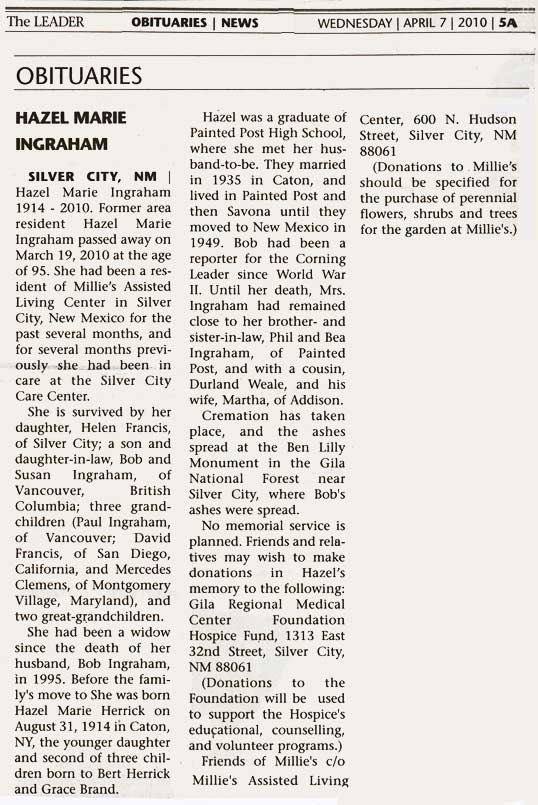
This page written and researched by Susan Overturf Ingraham, wife of Robert Philip Ingraham, who is the son of Robert Mosher Ingraham and Hazel Marie Herrick. Last updated on July 27, 2025.
-
These three dots behave exactly like a footnote. Click on them and you will get more information about the topic. ↩︎
-
"Aunt Julia" mentioned here played a very important role in Hazel's mother's life (Grace), including letting Grace get married in her home in Ottawa, Ontario, Canada. There is more to this story which is currently being researched. Eventually this page might have to be rewritten! ↩︎
-
In his biography, Bob does not mention his maternal grandparents, George Mosher and Gertrude Wheeler, though he would often talk about some of his aunts on this side of the family. ↩︎
-
A family secret for years, and may not be possible ever to prove, Samuel Perkins Brand and Martha Hatch may have been Grace's aunt and uncle rather than her parents. ↩︎